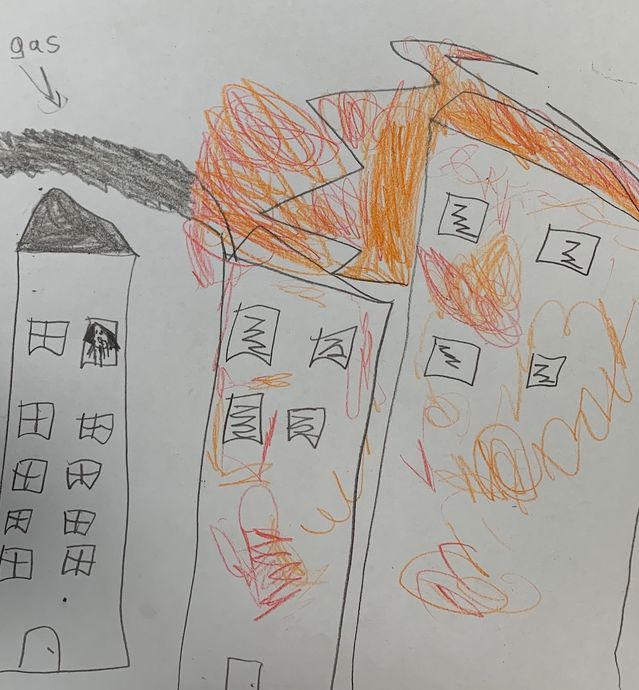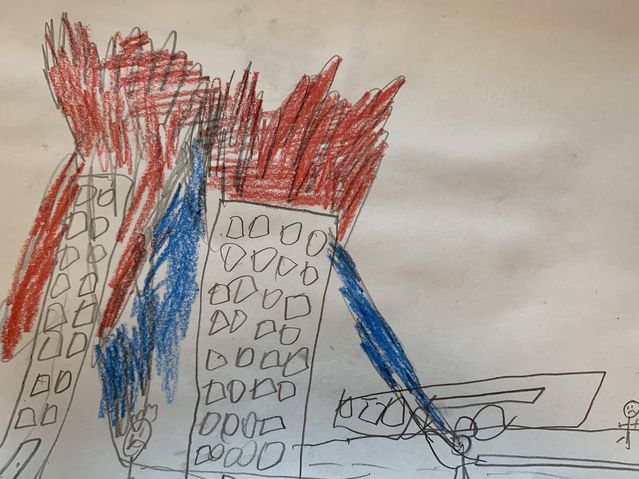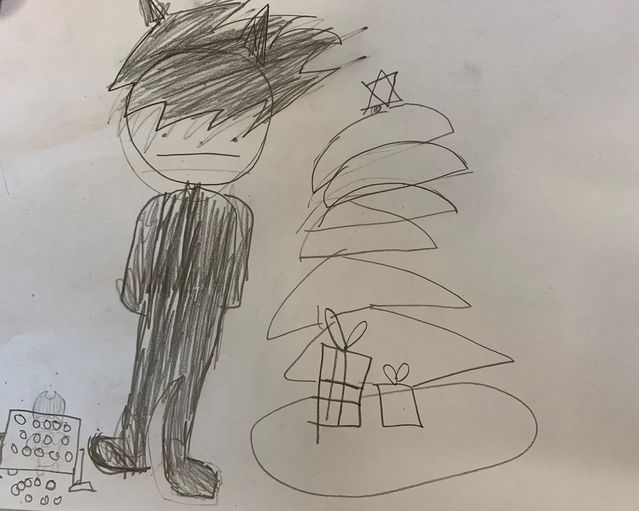Trauma
Interview: Expressive Arts Help Children Cope With Trauma
A poet and artist describes her school visit following a neighborhood disaster.
Posted January 13, 2020
Last month, students at Kirkbride Elementary School in South Philadelphia witnessed an explosion and fire that took place a block away from the school. Although they sheltered together in the school’s gym, they experienced the fire, blaring sirens, helicopters whirling overhead, and the dramatic presence of 150 first responders. Several students’ homes were affected, families were displaced, and two people died.

Among the educators at Kirkbride the following day was Cathleen Cohen, Ph.D., a poet, artist, and board member at the non-profit ArtWell. Her work has appeared in a variety of publications, and she has received numerous awards for her activities focusing on interfaith relations and human rights in the greater Philadelphia area.
I recently had the opportunity to talk with Cathy about her experience at Kirkbride that day and her work more generally. What follows is a transcript of our conversation, lightly edited for length and clarity.
RE: How did you happen to be at Kirkbride the morning after the explosion, and what was that like?
CC: That morning I accompanied Need In Deed’s Janet Chance for my usual poetry workshops in Ms. G’s and Ms. C’s third-grade classes. Need in Deed is a wonderful organization that sponsors service learning in classrooms where students learn about and get involved with social action projects related to their communities and the larger world.
Of course, nothing at school was “as usual” that morning. The children alternately buzzed with anxious talk and seemed subdued. I felt anxious myself, hoping what I might offer would be spacious enough to allow for them to process and express their experiences as well as find some comfort.
“We’re very sorry for what happened yesterday,” we told them, “and so glad to see you here now, safe and sound.” We began with a mindfulness stretch, relaxing different parts of our bodies, hands on our hearts, feeling the solidness of the ground, reassuring ourselves that we were present and safe in the moment.
We also improvised and voiced this poem:
Safe and sound,
Safe and sound.
Breathe the air
And feel the ground.
Stand with a friend,
Hold a hand.
If trouble comes,
We understand.
We’re safe and sound,
Safe and sound.
Breathe the air
And feel the ground.
RE: Cathy, you’re also an artist. How were you able to use art to help the students that day?
CC: I asked students to do some drawing. They could draw what they experienced the day before, or any feelings or stories or questions they wanted to explore. But first I wanted to really clearly mark that it was over. I asked that they draw themselves after the event, perhaps right now, surrounded by friends or imagining the upcoming weekend with family and friends over the holidays. I wanted them to notice and record being safely here now, before recalling such a scary event.
The students drew pictures of families gathering, sitting at meals, petting their cats, playing “as usual” the way children do. They also drew heartfelt pictures of trauma: exploding houses, helicopters, fire, and smoke pouring forth from roofs.


Janet and I joined the teachers in moving throughout the room, listening to students explain what was happening in their pictures. We were moved to witness their resilience, how connected they were with each other. “Do you know what I did yesterday?” asked one boy. He explained that he played tic-tac-toe with his friend and asked for hugs when he felt scared. Indeed, his teacher explained that many of the students sat with their arms around classmates during the lockdown in the gym.


RE: What other activities were part of that day with the children?
CC: We read several poems from Georgia Heard’s excellent collection, This Place I Know: Poems of Comfort. Then we wrote poems about ways we could help ourselves feel and be safe when scary things happen.
Here are two collaborative poems written during our workshops. Surely it will take time to process and incorporate their experiences and feelings after such trauma. But I marvel at the students’ resilience and caring for each other.
To Feel Safe (Ms. Grant’s class)
I saw a fire in the store
but I was safe.
My grandma was with me.
I breathe in and feel calm.
To be safe, I run to the basement
to be with my family.
I have fun with my family playing games.
I touch a fluffy.
I hear songs and videos and I eat cookies.
I play with my friends.
I play my iPad and listen to songs.
If I am scared I pet my cat.
I go to my brother’s room
to play with my sister and the cat.
I stay home.
I listen to music.
I am with my mom or dad or with a friend.
I help others.
I feel all the love in my heart
from a BFF and family together
to have fun and love.
It is a happy ending in my heart.
******
To Make Me Feel Safe (Ms. Caselle’s Class)
When I’m sad
I snuggle up with my stuffed animals
or play on my Xbox.
To make me feel safe
I go steal cookies!
I go to my mom’s bed on my dad’s side of the bed.
I bury my plush family in the bed and watch my iPad
while I eat my cookies.
I feel safe when I ask for $100.
I like to call my Gramma when I feel sad.
I play cards.
I hug my mom.
I steal cheese from the fridge
and watch TV (not too much TV).
I take a bag of chips or an ice cream box
and then I go on my bed and sit
and watch a movie or a video.
I play with Nick and play tic-tac-toe.
I hug my dog.
I go on my iPad.
I hug my mom or sister.
I play with my stuffed animals.
I read books.
I hit the punching bag.
I go to play with my sister and dolls together.
I hide under my blanket.
I play with my studies and do art.
I go to bed.
I snuggle and drink hot cocoa.
My grandma’s cat comes to me and
I grab a brush to pet him and feed him.
I snuggle with my dogs.
I snuggle with stuffed animals.
I make cookies and hot cocoa and
we all play Monopoly and I pet the cats.
When I’m sad snuggle up with my stuffed animals
or play on my Xbox.
I like to cuddle my teddy bear.
I bounce on my bed.
I scream!
I annoy my sister.
I hug my mom.
I steal all the bags of chips!
What I do to be safe is
I do not panic.
RE: You’ve also worked a lot with other communities that have experienced trauma, deprivation, and alienation. Can you say a bit about that, Cathy?
CC: For the last 20 years, I’ve been involved in teaching through the “We the Poets” program at ArtWell, an arts education nonprofit. The program grew out of a desire to bring expressive arts to underserved students from a wide range of communities, many experiencing community violence and trauma. We’ve also used our techniques to foster relationships between children of different faiths and backgrounds. I’ve shared this work with children and educators in Israel, including a Bedouin high school, Arab village school, universities, Arab-Jewish schools, and the like.
RE: What have you found to be generally true and important, from a trauma perspective, in working with the kids you do?
CC: It seems essential for children to have the time and space to process their experiences (whether traumatic or not) and give voice to an attentive audience. In teaching poetry, we try to establish a vocabulary of feelings. We support children in learning to use creative expression to help cope with even the most difficult emotions. This can be through avenues such as play, storytelling, drama, music, dance, poetry, or visual art. When teachers foster these activities, it enhances learning and builds healthy practices beyond the classroom.
Wherever I’ve worked, my goal has always been to help children process, “metabolize,” and own their narratives and express feelings, thoughts, questions, and worries.
RE: A final question. Are there ways that people without formal training can get involved and contribute to this kind of work?
CC: Yes, there are many wonderful nonprofits locally and beyond that serve children. Often nonprofits such as ours offer ways to contribute, not only financially but also through volunteering and serving on committees and boards. ArtWell has a tutoring program which matches challenged readers with adults who tutor them weekly. Several of my friends love mentoring this way. It’s a win-win!
RE: Thanks very much, Cathy.




